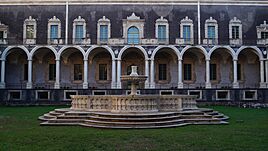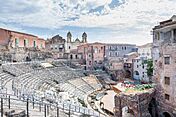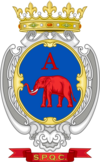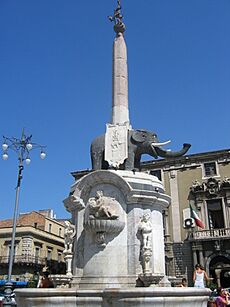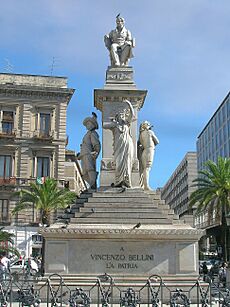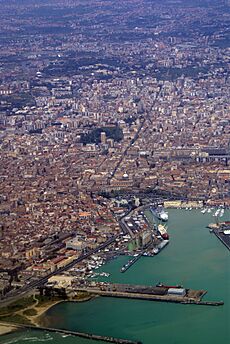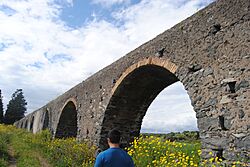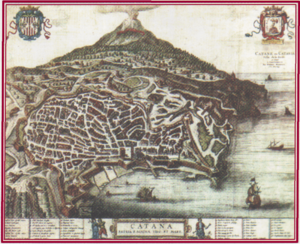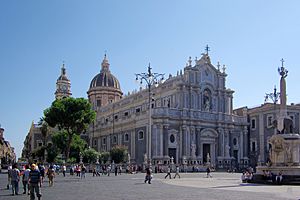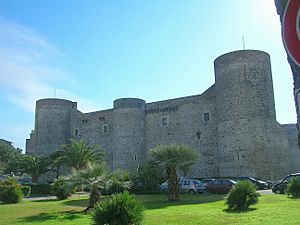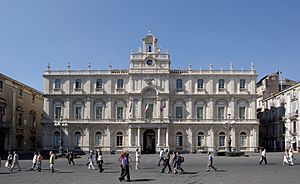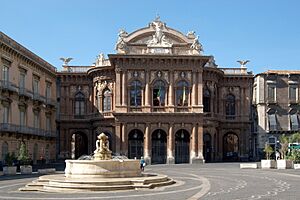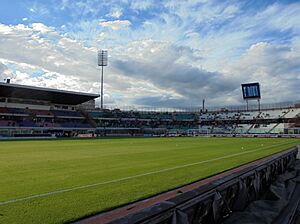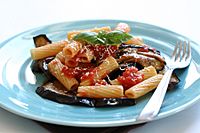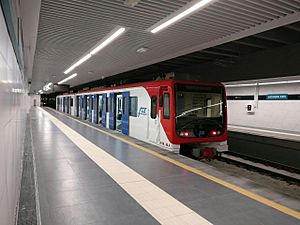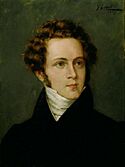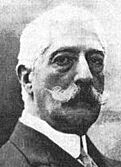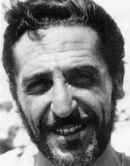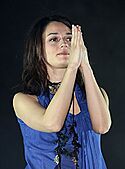Catania facts for kids
Quick facts for kids
Catania
|
|||
|---|---|---|---|
| Comune di Catania | |||
|
Monastery of San Nicolò l'Arena
Roman Theatre of Catania
Badia di Sant'Agata
Elephant Fountain
Catania Cathedral
Ursino Castello
Basilica della Collegiata
|
|||
|
|||
| Country | Italy | ||
| Region | Sicily | ||
| Frazioni | Bicocca, Codavolpe, Junghetto, Pantano d'Arci, Paradiso degli Aranci, Passo Cavaliere, Passo del Fico, Passo Martino, Primosole, Reitano, Vaccarizzo, Villaggio Delfino | ||
| Area | |||
| • Total | 182.90 km2 (70.62 sq mi) | ||
| Elevation | 7 m (23 ft) | ||
| Population
(1 January 2019)
|
|||
| • Total | 311,584 | ||
| • Density | 1,703.58/km2 (4,412.24/sq mi) | ||
| Demonym(s) | Catanese | ||
| Time zone | UTC+1 (CET) | ||
| • Summer (DST) | UTC+2 (CEST) | ||
| Postal code |
95100
|
||
| Dialing code | 095 | ||
| Patron saint | St. Agatha | ||
| Saint day | 5 February | ||
Catania is the second-largest city in Sicily, an island in Italy. It is known for its important roads, railways, and Sicily's main airport. The city is on Sicily's east coast, right by the Ionian Sea. It sits at the base of the active volcano Mount Etna. Catania is the capital of the Metropolitan City of Catania, which is a large area with many towns.
Catania has a long history. It was founded around 729 BC by Greek settlers. The city has been destroyed many times by natural disasters. A huge earthquake in 1169 almost wiped it out. Then, in 1669, lava from Mount Etna nearly covered the city. Another big earthquake in 1693 caused a lot of damage.
Despite these challenges, Catania has always bounced back. In the 14th century, it was a major cultural and artistic hub in Italy. It was home to Sicily's first university, started in 1434. Many famous Italian artists and writers, like the composer Vincenzo Bellini, lived here. Today, Catania is a key center for industry, trade, and logistics in Sicily. Its airport is the biggest in Southern Italy. The old part of Catania, with its beautiful baroque architecture, is a UNESCO World Heritage Site.
Contents
- What Does the Name Catania Mean?
- Catania's Location and Weather
- Who Lives in Catania?
- Catania's History Timeline
- How Catania is Organized
- What to See in Catania
- Catania's Economy
- Learning in Catania
- Catania's Culture
- Sports in Catania
- Food and Local Dishes
- Getting Around Catania
- Famous People from Catania
- Catania's International Connections
- Images for kids
- See also
What Does the Name Catania Mean?
The name Catania has an interesting history. The first people in Sicily, called the Sicels, named their villages based on the land. The word katane might mean "grater" or "uneven ground." This makes sense because the city has often been rebuilt on black lava rock.
Around 263 BC, the city was also called Catina or Catana. Catina might have come from a Latin word meaning "a gulf" or "a basin," describing the city's shape.
When Catania was part of an Islamic kingdom around 900 AD, it was called Balad al-fīl or Madīnat al-fīl, meaning "Village (or City) of the Elephant." This name likely came from an old lava sculpture of an elephant in the city's main square. This elephant was thought to protect the city. Another Arabic name, Qaṭāniyyah, might mean "place of beans" because many beans and other plants were grown in the plains around the city.
Catania's Location and Weather
Catania is at the foot of Mount Etna. This location has both good and bad sides. Volcano eruptions have destroyed parts of the city. But the volcanic ash also makes the soil very fertile, which is great for growing grapes.
Two hidden rivers flow under the city: the Amenano and the Longane. The Amenano river can be seen at one spot near Piazza Duomo.
Catania's Climate
Catania has a hot-summer Mediterranean climate. This means it has very hot summers. Temperatures can reach over 40°C (104°F) almost every year.
Winters are mild, but it can get quite cool at night. Most of the rain falls from October to March, leaving late spring and summer very dry. The city gets about 500 millimeters (20 inches) of rain each year. Snow is rare because Mount Etna protects the city from cold northern winds. Light snow has fallen in recent years, but heavy snow is very uncommon.
Who Lives in Catania?
As of 2015, about 315,601 people lived in Catania. Slightly more than half of the residents are female. Young people under 18 make up about 20.5% of the population.
The city's population has slightly decreased over the years. This is mainly because many people have moved from the city center to live in the suburbs. So, while the city itself might have fewer people, the total population of the wider Metropolitan area has grown.
Most people in Catania are Italian. There are also smaller groups of immigrants from places like Sub-Saharan Africa, South Asia, and other European countries like Ukraine and Poland.
Catania's History Timeline
Early Beginnings
Around 729 BC, Greek settlers from a nearby town called Naxos took over an old village named Katane. They made it a Greek colony called Katánē. The local people quickly adopted Greek ways.
The city's main fort was on Monte Vergine hill, just west of today's city center. Catania's port was very busy and important for shipping grain from the rich plains nearby.
Greek City Life
Catania was a center for learning in ancient Greece. A famous law-maker named Charondas was born here. Poets like Ibycus and Stesichorus also lived in Catania. Stesichorus was supposedly buried in a grand tomb outside one of the city gates.
In 476 BC, a ruler from Syracuse named Hieron took control of Catania. He forced out the original people and brought in his own subjects, changing the city's name to Aetna, after the volcano. After Hieron died, the original people returned in 461 BC.
Catania became very successful after this. However, in 415 BC, it got involved in a war between Athens and Syracuse. Catania became an ally of Athens. Later, in 403 BC, Dionysius I of Syracuse attacked the city, sold its people as slaves, and brought in new soldiers. The Carthaginians also took control of Catania for a time.
Under Roman Rule
During the First Punic War in 263 BC, Catania became one of the first Sicilian cities to join the Roman Republic. It became a rich and thriving city under Roman rule.
Around 135 BC, rebel slaves took over the city for a short time.
In 121 BC, a huge eruption of Mount Etna covered much of Catania with lava and ash. Because of this, Rome excused Catania from paying taxes for 10 years. The fertile plains near Catania, which grew a lot of grain, became part of the city.
Cicero, a famous Roman speaker, said Catania was a wealthy city in his time. It kept its own local government.
During a revolt led by Sextus Pompeius around 44 BC, Catania joined his forces. After the Roman leader Augustus won, Catania suffered. But Augustus later made it a "colony" by settling Roman soldiers there, which helped the city become prosperous again.
Catania had the longest Roman aqueduct in Sicily, stretching 24 kilometers (15 miles) from springs in Santa Maria di Licodia. The city remained important and prosperous throughout the Roman Empire.
Middle Ages
In 440–441 AD, the Vandals attacked and looted Catania. It was later ruled by the Ostrogoths and then by the Eastern Roman Empire (Byzantines) until the 9th century. It was an important Byzantine center on the island.
For two centuries, Catania was part of an Islamic kingdom. Then, in 1072, the Normans took control. In the late 1100s, German soldiers looted the city. In 1232, Catania rebelled against Frederick II, who then built a large castle called Castello Ursino. He also made Catania a royal city, reducing the power of the bishops.
Catania was a key city in the Sicilian Vespers revolt in 1282 against French rule. It became a royal seat for the Aragonese kings of Sicily. In 1434, King Alfonso V founded the Siciliae Studium Generale here, which is the oldest university in Sicily.
Modern Times
When Castile and Aragon united in the early 1500s, Sicily became part of the Spanish Empire. Catania rebelled against Spanish rule in 1516 and 1647.
In 1669, a huge Etna eruption caused great damage around the city. Luckily, the city walls protected most of Catania by diverting the lava into the port. However, in 1693, a massive earthquake almost completely destroyed the city. Catania was then rebuilt in the beautiful Baroque architecture style you see today.
In 1860, Giuseppe Garibaldi's forces took Sicily, and Catania became part of the newly unified Italy.
The early 20th century saw more challenges. Mount Etna erupted in 1923 and 1928, with the 1928 lava flow destroying a town. During World War II, Catania was heavily bombed by Allied forces because it had important airfields and a port. The city suffered 87 air raids, causing huge damage and forcing many people to leave. British forces captured Catania on August 5, 1943.
After the war, Catania worked hard to rebuild and grow. In the 1960s, it grew so fast economically that it was called the "Milan of the South." Today, Catania faces some economic challenges, but it still has a strong economy with industries, farming, and a growing tourism sector.
How Catania is Organized
Catania is part of the Metropolitan City of Catania, which was created in 2015. This larger area includes Catania city and 57 other towns, with a total population of over 1.1 million people.
The Metropolitan area of Catania includes the city itself and 26 nearby towns. These towns are closely connected to Catania's economy and social life, forming a large urban area.
The city of Catania itself is divided into six smaller administrative areas called circoscrizioni. These areas help manage local services.
What to See in Catania
The symbol of Catania is u Liotru, which is the Elephant Fountain. This fountain, built in 1736, features an ancient elephant sculpture made of lava stone, topped with an Egyptian obelisk.
The name u Liotru comes from a legend about a nobleman named Heliodorus. He was said to be a sorcerer who could magically ride the lava elephant. Another story says he could turn into an elephant himself!
The elephant symbol might come from the ancient past. Sicily once had dwarf elephants. Ancient Greeks might have found their large skulls and thought they belonged to giants with one eye, leading to the legend of the Cyclops.
Ancient Buildings
Catania has been buried by lava 17 times in history. Under the current city, you can find layers of the Roman city and even older Greek cities. Many ancient Roman buildings were destroyed by these events. Today, you can visit several ancient ruins as part of an archaeological park.
Some ancient buildings you can see include:
- Greek-Roman Theatre of Catania and Odeon (from the 2nd to 3rd century AD)
- Amphitheatre of Catania
- Roman Forum
- Old Christian churches, underground tombs, and catacombs
- Roman Baths, like the Achillean Baths
Baroque Churches and Historical Sites
The Baroque city center of Catania is a UNESCO World Heritage Site. It features many beautiful churches and buildings rebuilt after the 1693 earthquake.
Some notable churches include:
- Catania Cathedral (first built in 1070, rebuilt after 1693)
- Sant'Agata, Badia di (1620), a church and monastery
- San Benedetto (1704–1713), a church and monastery
- Basilica della Collegiata, known for its beautiful Baroque front
- San Nicolò l'Arena (1687), a large, unfinished church with a huge Benedictine Monastery of San Nicolò l'Arena
Other Important Places
- Ursino Castle: Built by Emperor Frederick II in the 13th century.
- Elephants' Palace: This building, designed by Vaccarini, is where the city's government offices are located.
- University Central Palace: The main building of the University of Catania, with offices and the main library.
- Biscari Palace: A grand historic palace.
- Porta Garibaldi: A triumphal arch built in 1768.
- Bellini Theatre: A beautiful opera house that opened in 1890.
- Bellini Garden, or Villa Bellini: A lovely public park.
- Catania Botanical Garden: A garden with many different plants.
Catania's Economy
Catania is the most important economic and industrial center in Sicily. It is known for its petrochemical industry and for mining sulphur. In 2000, Catania was the 14th richest city in Italy.
In the late 1800s and early 1900s, Catania became very industrial, earning it the nickname "Southern Italy's Manchester." However, its economy struggled after World War I. After the destruction of World War II, Catania's economy started to grow rapidly in the 1950s and 1960s. This fast growth led to it being called the "Milan of the South." Many people from smaller towns in Sicily moved to Catania for jobs.
Today, Catania has a strong industrial and farming sector. Its tourism industry is also growing quickly, with many visitors coming to see the city and Mount Etna. Big companies like STMicroelectronics have offices here. New developments like Etnapolis, a large shopping mall, and Etna Valley, a high-tech area, are helping Catania's economy.
Etnaland, a big amusement and water park near Catania, is the largest of its kind in Southern Italy. It attracts thousands of tourists.
Learning in Catania
The University of Catania, founded in 1434, is the oldest university in Sicily. It has 12 faculties and over 62,000 students. It offers many different study programs.
Catania also has the Scuola superiore di Catania, which is connected to the university and focuses on excellent education. There is also the Istituto Musicale Vincenzo Bellini for music studies and the Accademia di Belle Arti for art studies.
Catania's Culture
The famous opera composer Vincenzo Bellini was born in Catania. His birthplace is now a museum. The Teatro Massimo Vincenzo Bellini, an opera house, opened in 1890 and shows many different operas.
Giovanni Verga, a great Italian writer, was also born in Catania. His novels often showed the lives of ordinary people in Sicily.
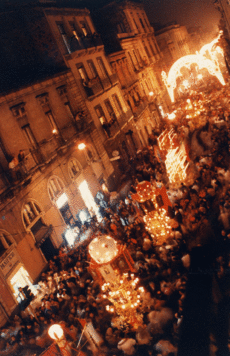
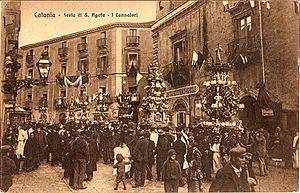
The city's patron saint is Saint Agatha. Her festival, the Festival of Saint Agatha, is celebrated with religious parades and events every year on February 5.
Catania is home to the newspaper La Sicilia and the TV channel Antenna Sicilia. It also hosts Etna Comics, a popular comic book convention, and the Catania Tango Festival, an international tango event.
In the late 1980s and 1990s, Catania had a lively music scene. Many indie pop and rock bands, local radio stations, and independent music labels started here. Famous artists like Carmen Consoli and Mario Venuti came from this creative time.
Sports in Catania
Catania has many sports clubs. The most famous is the Catania FC football team, which has many supporters. Another well-known club is AS Orizzonte Catania, a leading women's water polo team. They have won many national and European championships.
Catania is the most successful city in team sports in Southern Italy, with 76 national championship titles. Many athletes from Catania have also won world, European, and national titles in individual sports. In the Olympic Games, athletes from Catania have won a total of 7 gold, 8 silver, and 4 bronze medals.
The city also hosts the Catania-Etna car race. It has also hosted several international sports events, including the 1997 Summer Universiade and the 2011 World Fencing Championships.
Food and Local Dishes
Food is a big part of Catania's culture. The local food has its own special flavors, while also being part of Sicilian cuisine.
Street food is a great way to try traditional dishes. Arancini are famous rice balls, shaped like a cone in Catania to look like Mount Etna. They are filled with different ingredients, coated in breadcrumbs, and deep-fried. Other street foods include cipollina (puff pastry with onion and tomato) and crispelle (fried dough balls).
During festivals, you can find stalls selling calia e simenza (toasted chickpeas and pumpkin seeds). In old markets, you might find unique dishes like quarumi (pork tripe) or mauru (edible seaweed). Horse meat is also very traditional and is often grilled on the street.
Besides street food, popular dishes from Catania include:
- Pasta alla Norma: Pasta with fried eggplant, tomato sauce, and ricotta cheese. It's named after an opera by Vincenzo Bellini.
- Pasta cco niuru: Pasta with cuttlefish ink.
- Scacciata: A pie filled with tuma cheese, popular at Christmas.
Catania is also famous for its pasticceria (pastries and cakes). Treats change with the seasons and holidays. During the Saint Agatha Festival, you can find cassatelle (small cassatas) and olivette (olive-shaped almond paste). In summer, granita (a frozen dessert) is very popular.
You'll find drink kiosks everywhere, serving soft drinks made by mixing fruit syrups with soda.
Local products from the area include blood oranges, pistachios from Bronte, olive oil, cactus fruit, cherries, and wine.
Getting Around Catania
Catania has a busy seaport, an international airport, and several railway stations. The main train station is Catania Centrale. It is also a major hub for Sicily's motorways, connecting to Messina, Palermo, Syracuse, and Gela.
The Circumetnea is a special narrow-gauge railway that circles the base of Mount Etna for 110 kilometers (68 miles).
Catania also has an underground railway called the Metropolitana di Catania. It started in 1999 and now runs for 8.8 kilometers (5.5 miles) through the city center. There are plans to extend the line to the airport.
On average, people in Catania spend about 56 minutes commuting on public transport on a weekday. They usually wait about 23 minutes at a stop. A typical trip on public transport is about 4.7 kilometers (2.9 miles).
Famous People from Catania
Many famous people have come from Catania, including:
- Vincenzo Bellini (1801–1835), a well-known composer.
- Giovanni Verga (1840–1922), a famous writer.
- Franco Battiato (1945–2021), a singer-songwriter and filmmaker.
- Carmen Consoli (born 1974), a popular singer-songwriter.
- Luca Parmitano (born 1976), an astronaut.
- Pippo Baudo (born 1936), a famous TV presenter.
- Leo Gullotta (born 1946), an actor.
- Miriam Leone (born 1985), who was Miss Italia in 2008.
Catania's International Connections
Catania has sister city relationships with several cities around the world. These connections help promote cultural exchange and friendship.
Some of Catania's sister cities include:
- Grenoble, France (since 1961)
- Phoenix, United States (since 2001)
- Ottawa, Canada (since 2002)
- Oxford, England, UK (since 2012)
Influence on Adelaide, Australia
Colonel William Light, who planned the major Australian city of Adelaide, was inspired by Catania. In 1823, he wrote about Catania's wide streets crossing at right angles. This design became the basis for his plan of Adelaide.
Images for kids
-
Maria Teresa de Filippis winning the Catania-Etna in 1955
See also
 In Spanish: Catania para niños
In Spanish: Catania para niños


